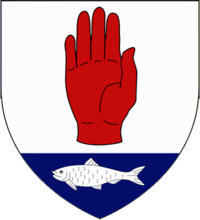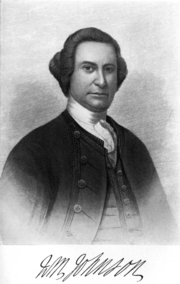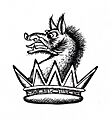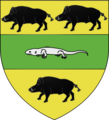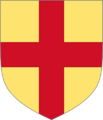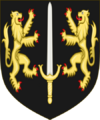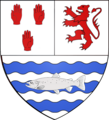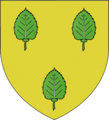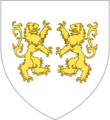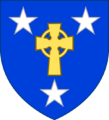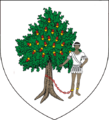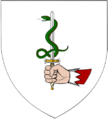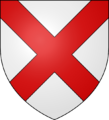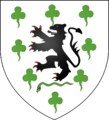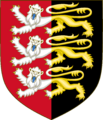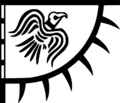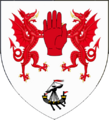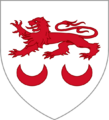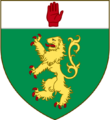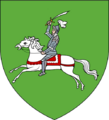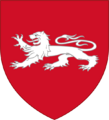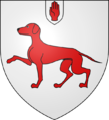O'Neill dynasty facts for kids
| O'Neill Ó Néill |
|||
|---|---|---|---|
Quick facts for kids 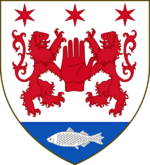 |
|||
| Parent House: | Cenél nEógain | ||
| Titles: | *High Kings of Ireland
Sept titles:
International titles:
|
||
| Founder: | Flaithbertach Ua Néill | ||
| Final Ruler: | Hugh O'Neill, Earl of Tyrone | ||
| Current Head: | By sept Chief | ||
| Founding Year: | Late 10th century | ||
The O'Neill family (called Ó Néill in Irish) is a very old and important family from Ireland. They were powerful leaders and kings in Ireland for hundreds of years. They were kings of a region called Cenél nEógain. They were also one of the most important families of the Northern Uí Néill group, along with the O'Donnell dynasty. Some O'Neills believe their family came from the kings of Ailech, who lived a long time ago. They say they are related to a famous ancient king named Niall of the Nine Hostages.
Two members of their family, Niall Glúndub and Domnall ua Néill, even became High Kings of all Ireland. The O'Neill name comes from Niall Glúndub. From 1232 to 1616, the O'Neills were the rulers of Tír Eógain. This land was in the north of Ireland, in the province of Ulster. It included areas like modern County Tyrone, County Londonderry, and County Antrim. These places are now part of Northern Ireland.
Later, their land became part of the Kingdom of Ireland. The O'Neills were involved in many important events. These included Tyrone's Rebellion, the Flight of the Earls, the Irish Rebellion of 1641, and the Irish Confederate Wars.
Contents
Origins of the O'Neill Family
The O'Neill family says they are related to Niall Glúndub. He was a king of Ailech and a High King of Ireland in the 900s. Niall was part of the Cenél nEógain group, which was a branch of the Northern Uí Néill. The first person to use the O'Neill family name was Flaithbertach Ua Néill. He was Niall Glúndub's great-grandson.
For a while, between the 1080s and 1160s, the O'Neill clan was not mentioned much in Irish history records. In 1167, King Ruaidrí Ua Conchobhair of Ireland divided the kingdom of Ailech into two parts. One part went to Niall Mac Lochlainn (McLaughlin). The other part went to Áed Ua Néill. These two families fought for control over Tír Eoghain. The O'Neills finally won in 1241 at the Battle of Caimeirge. They defeated the MacLoughlin leaders.
The O'Neills of Tyrone
After 1241, the O'Neill family became very powerful. They took advantage of the changes happening after the Norman invasion of Ireland in 1169. They grew stronger and took control from other clans. The Bruce Invasion in Ireland caused a lot of damage. It weakened the Norman Earldom of Ulster, which ruled eastern Ulster. When this earldom fell in 1333, a part of the O'Neill family, called Clandeboye, took over many areas in eastern Ulster. They had been friendly with the Normans.
In 1493, Henry VII of England called Henry O'Neill, the King of Tyrone, "the Chief of the Irish Kings." He even gave him a special gift. The title of Earl of Tyrone was officially given in 1542.
Hugh O'Neill, Earl of Tyrone, fought against the English in Ireland for almost ten years. He finally gave up in 1603, just a few days after Queen Elizabeth died. Hugh stayed in Ulster as the Earl for five more years. But his life was threatened many times. In 1607, he secretly left Ireland for France. This event is famously known as the Flight of the Earls.
Hugh continued to use his title even after he fled. However, the Irish Parliament later said he had lost his title. His son, Shane O'Neill, also used the title. Shane's will left his title to his son, Hugo Eugenio O'Neill. Hugo died in 1641 while leading his regiment in Spain. Other O'Neill descendants who were exiled in Spain continued to use the title. They also commanded the Ulster Irish Regiment in the Spanish Army during the 1600s.
O'Neills of Clanaboy
The O'Neills of Clanaboy were a branch of the family. They were known for staying loyal to their family's traditions. They lost most of their land when it was taken by others. They preferred to keep fighting, as their ancestor Donald O'Neill, King of Ulster, had promised.
O'Neill Descendants in Europe
In the early 1700s, Felix O'Neill lost all his land. This happened because of strict laws against Irish Catholics. He moved to France and became a cavalry officer. He fought bravely with the Irish Brigade in the French Army. He fought against the British, Austrians, and Dutch. He died in a famous battle called Malplaquet in 1709.
Later, in 1896, Jorge O'Neill of Portugal showed his family history to officials in London. In 1900, a herald (a person who deals with coats of arms and family history) said that Jorge O'Neill was the only one who could show a direct male line from the O'Neill monarchs of Ireland. He was recognized as the leader of the O'Neill family. He was also recognized as the Earl of Tyrone, a title created in 1542.
Because of this, the Pope, the King of Spain, and the King of Portugal all recognized Jorge O'Neill. They called him the Prince of Clanaboy, Tyrone, and Ulster. They also called him the Count of Tyrone and the head of the Royal House of O'Neill. In 1945, the Chief Herald of Ireland also recognized his family as the Princes of Clannaboy. Jorge's grandson, Hugo, is the current Prince of Clanaboy. He has chosen not to claim leadership of the entire O'Neill family out of respect for his cousins.
O'Neills of Shane's Castle
Shane's Castle was an important home for the Clannaboy O'Neills. In 1722, Shane MacBrien O'Neill changed its name to Shane's Castle. After the Plantation of Ulster, some O'Neill families became part of the Church of Ireland. They also started marrying into new noble families from England.
One such marriage was between Mary O'Neill and Arthur Chichester. Mary was the daughter of Henry O'Neill, the lord of Shane's Castle. The current Barons of Shane's Castle trace their family line back to this marriage. The title "Baron O'Neill of Shane's Castle" was created in 1868. It was given to William O'Neill, who was a composer. He was born William Chichester but changed his name to O'Neill to inherit land from his cousin.
O'Neills of the Fews
"The Fews" is an area in County Armagh, Northern Ireland. It was once a smaller territory under the O'Neills of Tyrone. This O'Neill branch is related to the O'Neills of Tyrone through King Eoghan Mor, who lived around 1432–1436. King Eoghan's younger son, Aodh (Hugh), moved into the Fews area. He started a lordship there by taking land that belonged to the archbishop of Armagh.
During a rebellion in 1642, Sir Henry O'Neill from the Fews O'Neills supported the English. However, his sons and brothers joined the rebellion. Despite his choice, his lands were taken away. They were given to new settlers. Sir Henry O'Neill was sent away to Connacht, to land in County Mayo, Ireland. His son, Captain Sean/Shane O'Neill, went with him. Shane's sons took the surname MacShane, meaning "son of Shane." His grandson, William, later changed the name to Johnson. This William became a major-general in the American Colonial Army. He fought the French in New York during the French-Indian War. For his victory, he was made Sir William Johnson, 1st Baronet of New York in 1753.
When the Williamite War started in Ireland in 1689, Sir Henry O'Neill's son and grandson had both died. The heir to the family's land was Henry, who was a child and studying in France. Even though they didn't fight in the war, the O'Neill lands were taken by the Crown. Henry (1676-1745) should have gotten his lands back. But his relatives in Europe were afraid to send him back to Ireland. So, the property was sold in 1702–3. Henry had a brave career in the French army. He became a Lieutenant-Colonel and was killed in the Battle of Fontenoy in 1745. Henry was the last clear claimant to the lordship of the Fews.
Some O'Neill families today say they are related to this Henry O'Neill. However, old documents show he died without children. After Henry's death, Felix O'Neill (c1720-1792) was seen as the rightful leader of the Fews. Some even thought Felix had a strong claim to be the Chief of the entire O'Neill clan. A historian named Abbé James MacGeoghegan wrote in his book that Felix O'Neill was the leader of the Fews. He was also an important officer in the Spanish Army.
Felix O'Neill was born in Creggan, County Armagh. He was related to Aodh Buidhe O'Neill, Sir Henry O'Neill's brother. Felix left Ireland to join the Spanish Army. He is famous for rescuing Charles Edward Stuart ("Bonnie Prince Charlie") after the Battle of Culloden. Felix became a lieutenant general in the Spanish Army. His four sons also had good careers in the Spanish military. Most of them did not marry or have families. But the youngest son, Juan O'Neill (1768-1809), married and lived in Mallorca. He became a Captain-General and died at age 40. He left a one-year-old son named Felix. Through this son, the O'Neills of the Fews continued in Mallorca and later in Argentina.
Today, Dr. Tulio José O'Neille of Buenos Aires, Argentina, is believed to be the oldest living heir of the O'Neill of the Fews. His grandfather moved from Spain. He is a descendant of Lt. Gen Felix O'Neille (1720–1792), who served in the Spanish Army.
Another person, Don Carlos O'Neill, the 12th Marquis de la Granja, also claims to be a leader of the Fews. He says he is a direct descendant of Henry O'Neill, the last clear "Lord of the Fews." However, old records show that Henry had no children. So, their exact link to the historical O'Neills of the Fews is not fully clear. Their family can be traced back to a "Red" Henry O'Neill and his wife Hanna. Their children moved to Spain in the 1750s and 1760s.
Henry and Hanna O'Neill had a son named Arthur O'Neill in 1736. He was born in Dublin, Ireland. He joined the Spanish army in 1752 and was known as Don Arturo O'Neill de Tyrone. He worked for the Spanish government in their colonies for over 20 years. He became Governor of Yucatan and later Governor of West Florida. When he returned to Spain in 1803, he was given an important role in the Supreme Council of War. He also received the title of the 1st Marques Del Norte two years later.
Arthur's brothers included Lieutenant-Colonel Niall 'Nicolas' O'Neill y O'Kelly, who died in Zaragoza, Spain. His other brothers, Tulio and Enrique O'Neill y O'Kelly, moved to the Caribbean island of St. Croix. These two brothers were given permission by the Spanish king to start sugar plantations in Puerto Rico in 1783, but they never used it.
Tulio O'Neill y O'Kelly married Catherine O'Keefe y Whalen. They had two sons, Arturo O'Neill y O'Keefe and Tulio O'Neill y O'Keefe. Don Arturo O'Neill y O'Keefe was born in March 1782 on St. Croix. He married Joanna Chabert Heyliger there in 1802. Arturo and his brother asked for permission to claim their father's land rights in Puerto Rico, which was granted in 1804. Arturo moved his family there in March 1810. His descendants still live there today, as well as in Spain and the USA. Arturo became a Lieutenant Colonel in 1828. He inherited the title of Marques Del Norte from his uncle. He died in 1832 and is buried in Frederiksted, Saint Croix.
Don Tulio O'Neill y O'Keefe was born on St. Croix in September 1784. He became a General in the Spanish army. He fought bravely against the French in the Peninsular War. In 1819, he married Manuela de Castilla Quevedo, from a Spanish noble family. She died soon after their son, Don Juan Antonio Luis O'Neill de Castilla, was born. Tulio was promoted to Field Marshal in 1828. He announced the birth of a daughter to the King in 1830, who would become Isabel II of Spain. Tulio died in 1855. His son continued the family line and inherited his mother's titles. A later descendant also took the title of Marques Del Norte. This part of the family is often called the O'Neills of the Fews of Seville. It is currently led by Don Carlos O'Neill.
MacShane O'Neills
The McShane family is a close branch of the Tír Eoghain O'Neills. When Shane O'Neill, the Prince of Tyrone, was killed in 1567, he had about ten sons. They were all very young. Shane had said these children were his rightful heirs. So, after his death, they were raised by their mothers' families. These families included important Irish noble families like O'Donnell, Maguire, and MacDonald.
Sixteen years later, in 1583, some of the brothers met in Scotland. They were given an army of over 2000 Scottish soldiers. They returned to Ulster to try and take back their father's land and title. They surprised the English and the O'Neill chiefs. They took control of a large area in eastern Ulster. The English started calling them "the Mac-Shanes," which means "the sons of Shane" in Irish.
For seven years, they fought against Turlough O'Neill and Hugh Rua O'Neill. In 1590, Hugh O'Neill captured and executed three of the brothers. He imprisoned three more over the next ten years. Only two or three brothers and nephews were left, hiding in a forest. Two sons of Con MacShane O'Neill, Hugh and Ever, became leaders among the O'Neill clan living there. This family had saved them as babies. In 1593, Hugh MacShane was chosen as their new leader. This O'Neill branch then took on the "MacShane" surname to honor their loyalty to Shane O'Neill and his sons. Hugh McShane O'Neill was chief until 1622. His sons and grandsons continued to lead the family. They were active in wars and politics in Ulster, Ireland, and Spain for the next two centuries.
After the O'Neill kingship ended, many MacShanes joined the military in Spain and France. They even served in Irish regiments with their relatives. By the end of the 1600s, the Earl's family line in exile ended. The "Mac Shane" line then legally inherited the chiefship and title. This line is now in line for the Gaelic Principality and Earldom of Tyrone. Also, in 2015, an Irish law reversed the old ruling against Shane O'Neill. This means the family now has legal rights to the history and property of Conn Bacach O'Neill, Shane the Proud, and Hugh O'Neill, Earl of Tyrone.
In the early 1700s, many McShane families changed their surname to Johnson. This was to keep their property. A good example is Major General Sir William Johnson. His father was born a McShane but changed his name. This allowed his son to inherit his uncles' properties. By the early 1800s, most official documents showed no McShane families in their old areas. They had all changed their name to Johnson. However, in the 1900s, many Irish branches started using the Gaelic name again. Today, the clan includes McShane, Johnson, Johnston, and Shane. They are still active in Ulster, America, and Australia. The current family leadership is directly related to Shane's son Conn, and his son Hugh McShane O'Neill. They are involved in O'Neill clan activities.
Caribbean O'Neills
Tulio and Enrique O'Neill y O'Kelly, from the O'Neills of the Fews, moved to St. Croix in the 1770s. Tulio's sons, Arturo and Tulio O'Neill y O'Keefe, were given land in Puerto Rico in 1804. Arturo moved his family there in March 1810. His descendants still live there today, as well as in Spain and the USA.
The O'Neills of Martinique settled there in the early 1700s. In the next century, they claimed to be the Count of Tyrone. They said they were direct descendants of Hugh O'Neill, Earl of Tyrone. This claim is not proven. The main line of this family no longer has male descendants.
O'Neill Family Today
Scientists have studied the Y-chromosome, which is passed down from father to son. They found that many men in Ireland, Scotland, and even New York have a certain Y-chromosome type. They believe that about 2 to 3 million men share this type. They think these men are all descended from "a single early-medieval ancestor." This ancestor could be Niall of the Nine Hostages.
According to the TV show Finding Your Roots, several famous people have this Y-chromosome type. These include Bill O'Reilly, Stephen Colbert, Colin Quinn, Bill Maher, and the show's host, Henry Louis Gates Jr..
O'Neill Family Coats of Arms
Many people think that everyone with the same last name shares one coat of arms. But a coat of arms is actually property passed down through direct family lines. This means that many O'Neill families are related, but they don't all have the right to use the same coat of arms. Only direct descendants of an O'Neill who owned a coat of arms can use it.
The coat of arms for the O'Neills of Ulster was white with a red left hand. This family held the title of High Kings of Ireland. Because they were so important, the red hand became a symbol for Ireland, Ulster, and Tyrone. Today, a red right hand is often used instead of a left hand. When other O'Neill family branches were given or took on a coat of arms, they often included this red hand.
There are several legends that explain the red hand. A common story says that land was promised to the first man to touch the shores of Ireland. Many people were racing to the shore, including a man named O'Neill. He was falling behind. So, O'Neill cut off his left hand and threw it onto the beach. This made him the first to touch the land, winning all of Ireland as his prize. These legends seem to have started in the 1600s, long after the red hand was first used by O'Neill families.
Related Clans and Families
Some Scottish and Irish families may be related to the O'Neill dynasty. One story says that Anradhán, a son of Aodh Athlamháin, left Ireland for Scotland. He was said to have won land and married the daughter of the King of Scots. Anradhán was likely an 11th-century leader. Some old family histories say that the MacSweens, Lamonts, and MacLachlans are descendants of Anradhán. Other families like the MacSorleys, MacEwens of Otter, Gilchrists, and Highland Livingstones may also be related. The ancestry of the MacNeills is less clear.
Here are some other clans and families that are related to or connected with the O'Neill dynasty:
- Siol Alpin: The Uí Neill dynasty is said to be descended from Siol Alpin.
- Clan Bruce: This clan claims descent from the Connachta's Uí Briúin.
- Clan Cumming: This clan is related to the Uí Néill.
- Clan Donald: This clan traces its history back to the High Kings of Ireland, like Colla Uais and Conn of the Hundred Battles. They share an ancestor, Cairbre Lifechair, with the Uí Néill and the Connachta.
- Clan Ewen of Otter: This clan claims descent from the Ui Neill.
- Clan Gregor: This clan claims descent from Siol Alpin.
- Clan Irvine: This clan claims descent from the O'Neill.
- Clan Maccallum: This clan claims descent from the Ui Neill.
- Clan Macfie: This clan claims descent from Siol Alpin.
- Clan Mackinnon: This clan claims descent from Siol Alpin.
- Clan MacLean: This clan intermarried with the Ui Neill.
- Clan Macquarrie: This clan claims descent from Siol Alpin.
- Clan Macqueen: This clan is said to have the same descent as Clan Donald.
- Clan MacSweeney: As mentioned, this clan claims descent from Uí Néill.
- Clan Munro: This clan claims descent from the O'Neill.
- Clan Oliphant: This clan intermarried with the Bruce Clan.
- Clann Ruaidhrí: This clan claims descent from the O'Neill.
- Ó Brádaigh: This is a sept (a branch) of the O'Brian clan.
- De Burgh/Burke: This family married into the O'Brian Clan.
- O'Carroll clan: This clan is related to the Ui Neill.
- O'Cahan: This clan claims descent from the Uí Néill.
- Clan Ó Ceallaigh: This clan is related to the Uí Néill.
- Clann Cholmáin/O'Melaghlin-MacLaughlin Clan: This clan claims descent from the Southern Uí Néill.
- Ó Cléirigh Clan: This clan intermarried with the O'Neill.
- Ó Coileáin: This clan is related to the Uí Néill.
- Ó Conchubhair: This clan claims descent from the Connachta's Uí Briúin.
- Ó Conghalaigh: This clan intermarried with the Uí Néill.
- O'Connell Clan: This clan intermarried with the O'Brians.
- Ó Dálaigh Clan: This clan claims descent from a son of Niall of the Nine Hostages.
- Dempsey Clan: This clan intermarried with the O'Neill.
- O'Devlin clan: This clan claims descent from Uí Néill.
- O'Doherty clan: This clan claims descent from Uí Néill.
- O'Donnell dynasty Clan: This clan claims descent from Uí Néill.
- Donnellan clan: This clan is related to the Uí Néill.
- O'Donnelly Clan: This clan claims descent from Uí Néill.
- O'Donovan Clan: This clan intermarried with O'Brian clan.
- Ó Fionnagáin Finnegan Clan: This clan claims descent from the father of Niall of the Nine Hostages.
- FitzGeralds: This family intermarried with the Uí Néill.
- O'Gallagher Clan: This clan claims descent from Uí Néill.
- Gavigan Clan: This clan claims descent from the Southern Uí Néill.
- O'Gorman Clan: This clan intermarried with the Uí Néill.
- O'Grady Clan: This clan is distantly related to the O'Brian Clan.
- Ó hÁdhmaill: This clan is a branch of Cenél nEógain. They are descendants of Eochu Binneach, the son of Eógan mac Néill.
- O'Higgins family: This clan claims descent from the Southern Uí Néill.
- Ó Flaithbheartaigh Clan: This clan claims descent from the Connachta's Uí Briúin.
- Kavanagh Clan: This clan claims descent from the Connachta's Uí Briúin.
- O'Kelly Clan: This clan is related to the Uí Néill.
- Mac Brádaigh Clan: This clan claims descent from High King of Ireland Eochaid Mugmedon.
- McCarthy Clan: This clan intermarried with the O'Brian Clan.
- Magennis Clan: This clan intermarried with the O'Neill Clan.
- Maguire Clan: This clan is related to the Uí Néill.
- Clan Mackintosh: This clan is reported to be related to the O'Neill Clan.
- McGovern Clan
- McGuinness Clan: This clan intermarried with the O'Neill Clan.
- McCausland Clan: This clan claims descent from the Cenel Eoghain in County Londonderry and Tyrone, a branch of the Ui Neil.
- O'Murphy Clan: This clan claims descent from the Northern Uí Néill.
- O'Mahony Clan: This clan married into the O'Brian Clan.
- O'Reilly Clan: This clan was part of the Connachta's Uí Briúin Bréifne kindred. They were closely related to the Ó Ruairc (O'Rourkes) of West Bréifne.
- O'Rourke Clan: This clan claims descent from High King of Ireland Eochaid Mugmedon.
- Síol Muireadaigh Clan: This clan is related to the Uí Néill.
- O'Toole Clan: This clan intermarried with the Uí Néill.
Images for kids
-
Clan Highland Livingstones crest badge
-
The coat of arms of the O Kelly of Ui Maine,


